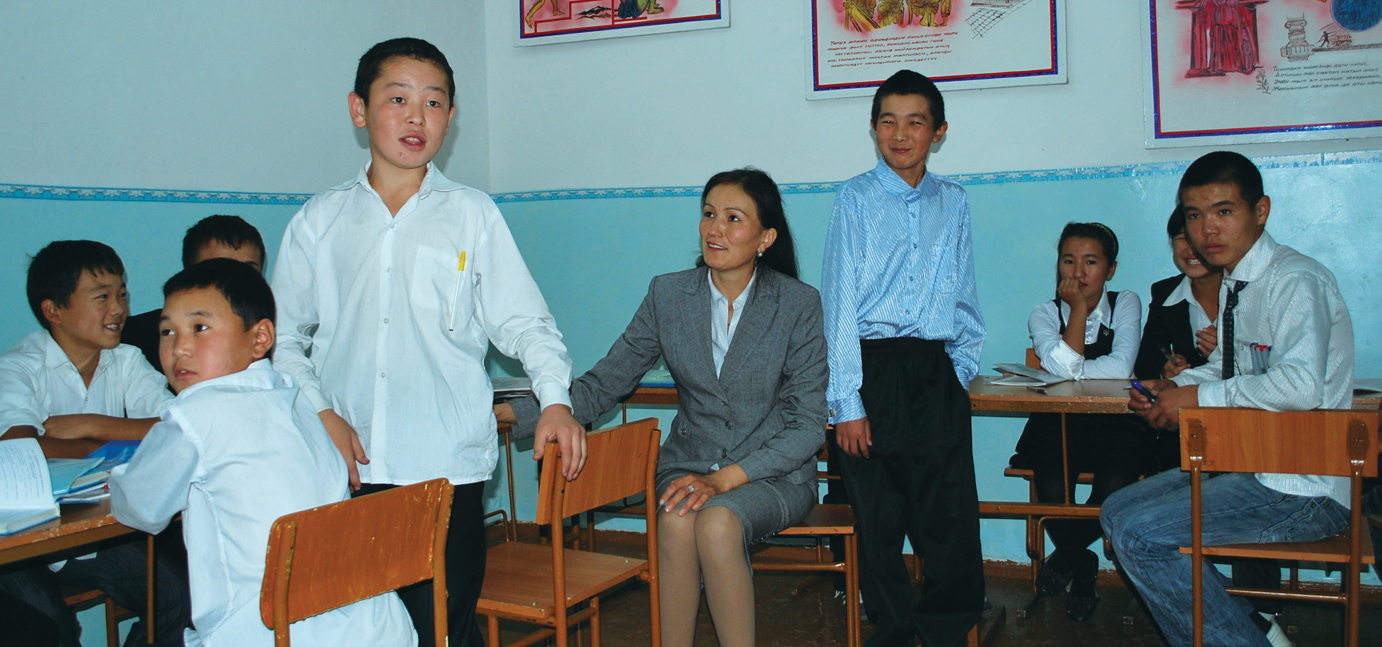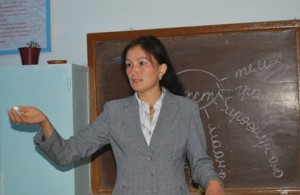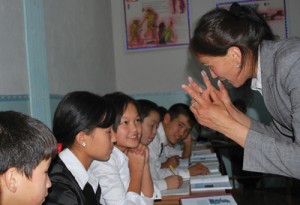
Nurmiza Kenjenbaeva is making a difference. On “Educators Day,” Kurmanbek Bakiev, the President of Kyrgyzstan, personally presented Kenjenbaeva with the nation’s Best Teacher of 2009 otorgar. Just six years into her teaching career, Kenjenbaeva, a USAID Quality Learning Project trainee, represents a new wave in Kyrgyz education that is moving beyond Soviet-style teacher training methods. Kenjenbaeva credits USAID’s Quality Learning Project with making a “big difference,” in her capacity to teach and motivate her students.
“I learned new methods of teaching and approaches, better planning, how to develop effective questions for students and how to correctly direct the student towards the aim of the lesson,” said Kenjenbaeva. “These things make the course very important and unique.” Quality Learning Project trainees also emphasize that, unlike other international cooperation efforts, USAID’s training is delivered in their native language.
Kenjenbaeva finds that her students are very open to the new student-centered teaching methods she acquired through USAID’s project. “I just started to use the student–centered methodology in my classes, right after the training I got from the Quality Learning Project,” said Kenjenbaeva. “In my classes, I divide the students into the groups, develop a proper questioning strategy, revise the lesson plan based on the guidance I received from the course, give the students my advice and give the information on the topic according to students’ level and skills.”

Kenjenbaeva says her students felt “lectured to” and bored under the old style of teaching. Ahora, she reports, students feel motivated and are more likely to ask questions and engage in discussions with their teachers and peers that promote higher order analytical skills. “I see myself as a person who gives direction and not a person with a pointer in hand,” says Kenjenbaeva.
The Quality Learning Project is helping Kyrgyz teachers like Kenjenbaeva use computers with projectors to convey presentations in the classroom. Teachers are learning how to videotape classes to show students what has been accomplished, especially when they are divided into working groups. “These things very effectively help the students to remember the information they receive, help their socialization and development process as individuals, allowing them to work on their weaknesses,” said Kenjenbaeva. "También, this method gives the chance for students to rely on their own experience, on what they see outside the classroom, not only what the teacher says.”
Kenjenbaeva is among nearly 600 teachers trained by the Quality Learning Project in these new teaching methods this past summer. The real impact of this training will be in improving the higher order thinking skills of Kyrgyz students. Teachers using these tools will reach a projected 32,831 estudiantes en 2009. By formally embracing these reforms, Kyrgyz education authorities are committing to using modern, active teaching methods to reach 73,554 more students in 2010, 128,546 en 2011 y 153,124 en 2012.

Asked about being selected best teacher of the year, Kenjenbaeva briefly reflected then said, “For me it is not only a ‘Victory’, but also a great responsibility. I feel, realize and recognize that I have to be a model to others, to develop my skills further, and work to better improve and develop my knowledge and share it with other teachers. But most important is to be a really good teacher for my students.”
Kyrgyz Academy of Education President Abakir Mamytov, who was a member of the award selection committee, noted that Kenjenbaeva far outpaced the second and third position holders for this year’s best teacher award, winning 31 points out of 40, while the second and third place contestants had scores of 9 y 6 respectivamente. The Kyrgyz Academy of Education recently unanimously voted to adopt the Quality Learning Project’s training methodologies into their institutes, ensuring Kenjenbaeva and her colleagues will continue to get support that makes a difference to preparing their students for the future.
